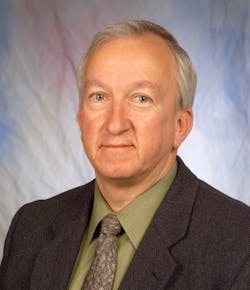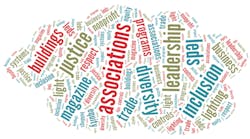With the COVID-19 pandemic raging, interest in germicidal technologies has surged as well. Ultraviolet radiation, specifically in the UV-C (100‒280 nm) band, is one technology that has gone from a very niche subject to the front pages of major newspapers because UV-C energy can deactivate the virus. So let’s consider the facts about germicidal UV-C and the sources that can produce such energy, including LEDs.
This column was prompted in part by a document we posted on the Center for Lighting Enabled Systems & Applications (LESA) website at Rensselaer Polytechnic Institute. We posted the top 10 questions that we have been asked relative to germicidal UV-C and a coronavirus such as SARS-CoV-2. Being that this column is in LEDs Magazine, we will revisit part of our top 10 list and add information that is specific to the use of UV-C LEDs in germicidal applications.
“Applied correctly” is the key phrase. The application depends on whether you seek to disinfect a surface, water, or air. Moreover, the germicidal efficacy depends on UV-C dosage. Dosage is determined by the radiometric power or watts delivered by a UV-C source, the distance from the target, and the duration of UV-C exposure. Distance is easily understood if, for instance, you want to disinfect a surface. In an air disinfection application, such as within an HVAC air duct, the distance would not be easy to estimate, as air disinfection can happen along the length of the duct through which UV-C radiation, along with the air, passes. Distance becomes an even more complex issue were you to try and use a UV-C source to disinfect all of the air in a room. Digging into the details, UV-C irradiance is measured in watts per unit area (typically W/cm2 in the US) and dose is calculated by multiplying the irradiance by the exposure time in seconds to get energy per unit area [typically joules (J)/cm2].
Moving to UV-C sources, LEDs are progressing as an alternative to mercury-discharge lamps in all types of UV-C applications. But just as early visible-light LEDs struggled to usurp legacy sources, UV-C LEDs face similar challenges. Generally speaking, UV-C LEDs have relatively higher cost, lower output power, and shorter lifetime. We’d expect the LED manufacturers to overcome those limitations over time.
However, LEDs are viable in some UV-C applications. The technology is already used embedded inside various water-disinfection systems ranging from a home kitchen faucet to pumps for water processing to water supply for soda dispensers. Indeed, mercury lamps would be tough to deploy in such applications due to size and potential contaminant concerns.
Most of the UV-C systems that have been in the news of late, however, are more focused on surface or air disinfection. And most of those systems use legacy lamps. For example, LEDs Magazine covered a United Airlines application for disinfecting surfaces in the jet cockpit and a JetBlue application that uses robots to disinfect the passenger cabin of a jet.
When you think about LEDs relative to a legacy source such as a mercury lamp, you have to think about how a system based on the source would operate. Source lifetime is very important for a mercury lamp because lamp warmup time and lifetime reduction with repeated on/off switching will require continuous operation even if the utilization rate (e.g., airflow) isn’t continuous.
LEDs can be powered on and off and achieve virtually full power output instantaneously. Cycling power does not damage the components. In an HVAC system, the UV-C LEDs could be turned off when air is not circulating. So the consideration of product lifetime changes. There is also evidence that LEDs used in pulse mode can deliver greater germicidal efficacy in some applications. Some research has shown such efficacy improvement in water disinfection and E. coli. The reason is not fully understood at this point and more research is needed.
We are also asked about LEDs at the so-called far UV-C wavelengths in the 222-nm range. For now, there are no LEDs available at such short wavelengths and the challenges of delivering such LED components appear stout. Our message, however, remains that only a thorough analysis of the application and the model of system usage will determine whether LED or legacy sources are the best choice in a project.
*Extended version of the column that appeared in the October 2020 issue of LEDs Magazine.
Get to know our experts
ROBERT KARLICEK, PhD, is director of the Center for Lighting Enabled Systems & Applications (LESA) at Rensselaer Polytechnic Institute (RPI). A longtime RPI professor, and an engineer and executive across multiple companies, Karlicek has deep experience in LED technology and application research & development. He frequently speaks to the LED and solid-state lighting (SSL) supply chain and academic communities on emerging SSL applications, as well as enabling technologies beyond the generation of visible illumination. He is a member of the Strategies in Light event advisory board, holds more than 50 patents, and has contributed to more than 50 published research studies in the semiconductor, electronics, and optoelectronics and lighting sectors.
LEAH SCOTT, MBA, is the business development lead, handling marketing and outreach at LESA. Scott has diverse public relations, program administration, and marketing communications experience across non-profit, military, and academic organizations. At LESA, she has been responsible for expanding the center’s partnerships, funding opportunities, and growth planning for long-term research and commercialization prospects.
For up-to-the-minute LED and SSL updates, why not follow us on Twitter? You’ll find curated content and commentary, as well as information on industry events, webcasts, and surveys on our LinkedIn Company Page and our Facebook page.







